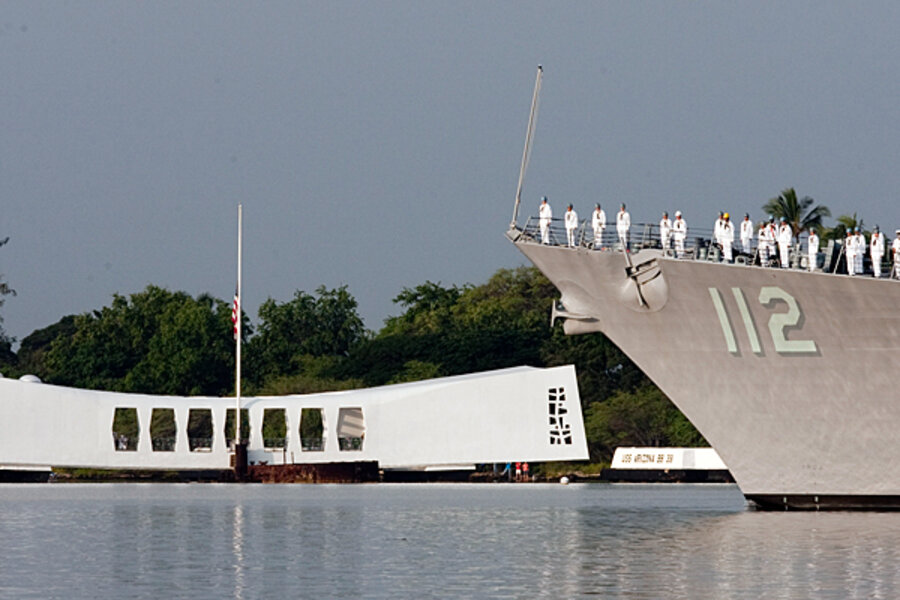Pearl Harbor resurrection: the warships that rose to fight again
| Washington
The attack on Pearl Harbor was a shocking defeat for the United States military. Japanese aircraft left a wrecking yard of burning and shattered warships in their wake. It’s a story every US school child still learns today.
But it’s not the whole story. Even as the smoke cleared the US Navy was hard at work untangling the mess and salvaging the fleet. Many of the sunken warships rose again to fight the Axis. Only three were damaged beyond repair.
“The salvage and restoration of those ships is a saga of expertise, tenacity, hard work, and invincible optimism,” wrote University of Maryland historian Gordon Prange in his classic history of Pearl Harbor, “At Dawn We Slept.”
When the waves of Japanese torpedo planes and aerial bombers swept over the US Hawaiian naval base their primary targets were seven battleships berthed alongside quays in Pearl Harbor proper and the Pacific fleet flagship USS Pennsylvania, which was in dry dock at the time.
Five of these battleships were sunk outright. That does not mean they were all blown apart by a rain of Japanese munitions.
“The available documentary evidence suggests that, of those five, the Oklahoma and Nevada were lost because of design defects, the West Virginia was simply overwhelmed by force her defenses were not meant to thwart, and the California was sunk because of the performance of her officers and crew,” wrote Thomas C. Hone in a Naval History Magazine survey of the damage republished in 2012.
The USS Arizona was destroyed by an explosion in its forward magazine that thoroughly wrecked the vessel. It lies on the floor of the harbor to this day, serving as a memorial to those who died on Dec. 7, 1941.
Three US cruisers, three destroyers, a target ship, and a minelayer were also sunk or heavily damaged.
Recovery work started immediately. Within three months most of the smaller ships and three of the battleships – the USS Pennsylvania, the USS Maryland, and the USS Tennessee – were either returned to service or refloated and steamed to the continental US for final repairs.
Resurrection of the rest of the fleet took longer. The shallow water of the anchorage made work on the battleships possible, but not easy. The USS Nevada, for instance, had one large and many small holes in her hull. Her interior was full of water and many compartments were burned out.
“Most significantly, her deficiencies in watertight integrity, which had led to her sinking in the first place, now had to be made good under very difficult circumstances,” notes the official Navy History and Heritage Command account of the effort.
Two men lost their lives after breathing poisonous gases that had accumulated in the ship’s interior. Eventually she was refloated and shipped to Bremerton, Wash., for repairs. She rejoined the active fleet in late 1942.
The USS California was even more damaged than her sister the Nevada. She had been holed by two torpedoes and a bomb and was fully submerged to the main deck level. Salvage teams built a wooden cofferdam on her superstructure, above the waterline, to aid in recovery and pumping efforts. Divers closed manhole covers and doors. After refloating and an extensive rebuild at the Puget Sound Navy Yard, the ship returned to the combat fleet in early 1944.
The USS West Virginia was the most severely damaged battleship that lived to fight another day. Her port side had been ripped up by eight Japanese torpedoes, according to the official Navy account, and her rudder had been ripped off by another.
The ship’s contents, from 800,000 gallons of fuel oil to projectiles for her guns, had to be removed before the ship could be patched and refloated. Work continued at Pearl Harbor until April, 1943. Extensively refitted at the Puget Sound Navy Yard, the West Virginia returned to service in July 1944 “and took an active part in the Pacific War’s final year,” according to the Navy.
The target ship USS Utah, and the battleships USS Arizona and Oklahoma, were the only ships the Japanese left beyond repair. The Utah remains on the Pearl Harbor floor along with the Arizona. The Oklahoma was raised after a massive effort but proved to be too damaged to return to service. [Editor's note: The original version of this story mischaracterized the Oklahoma's status.]
The effort to reclaim the fleet was, as the Naval History and Heritage Command says, “One of history’s greatest salvage jobs.” Divers spent over 20,000 hours underwater. Even in dry areas workers often had to wear gas masks to protect against the risk of toxic fumes.
The US Navy’s ability to limit the material damage of the Pearl Harbor attack was one of the reasons why Japanese military leaders later came to understand that on that fateful December day they had won a battle, but lost the war.
But in the end, time accomplished what they could not. All the recovered ships were eventually sold for scrap, or blown apart in target or atomic weapon tests, or otherwise decommissioned. (The USS Arizona is no longer a commissioned warship, but retains the right to fly the US flag as if she were on active duty.)
However, of the 101 US fighting ships present in Hawaiian waters on Dec. 7, 1941, one lives on. It is not a battleship, or a cruiser, or even a destroyer. It is the US Coast Guard Cutter Taney, which fired at attackers with its anti-aircraft guns from its Honolulu Harbor pier.
Today USCGC Taney is a museum ship located in Baltimore’s Inner Harbor. It is the last warship survivor of one of the nation’s darkest days still afloat.






